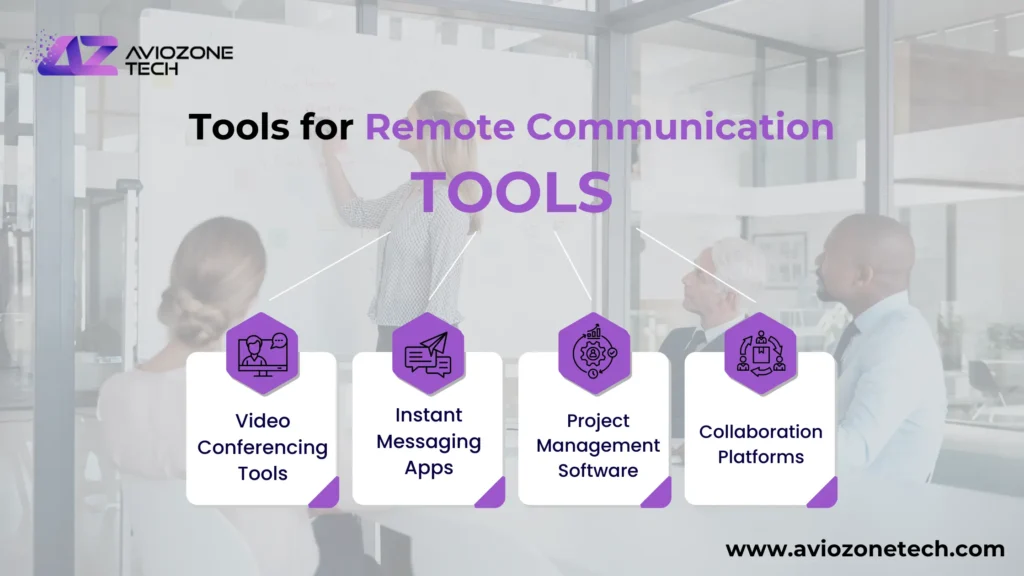Team Communication and Collaboration in a Remote Work Environment
The shift to remote work has transformed the way teams communicate and collaborate. In today digital world ensuring effective team communication and collaboration in a remote work environment is essential for maintaining productivity and employee satisfaction.
But how do teams overcome the unique challenges that come with working remotely? Lets explore this topic in detail.
Team Communication and Collaboration in a Remote Work Environment
Remote work also known as telecommuting that refers to the practice of working from a location other than a central office. This mode of work can be full-time, part-time or as a temporary arrangement.
Effective team communication and collaboration are facilitated through clear communication channels, regular virtual meetings and the use of collaborative tools like project management software and instant messaging platforms.
Building trust and fostering open dialogue are crucial to overcoming distance and ensuring seamless productivity among remote teams.
Over the years remote work has evolved from a niche practice to a mainstream norm especially accelerated by global events like the COVID-19 pandemic.
Challenges of Remote Work Communication
Lack of Face-to-Face Interaction
When team members are not physically present in the same location they miss out on the natural, spontaneous interactions that happen in an office environment. These impromptu conversations, such as hallway chats or quick desk-side discussions often help in building rapport and trust among colleagues.
Additionally, face-to-face interactions allow individuals to read non-verbal cues such as body language, facial expressions and tone of voice which are crucial for understanding the full context of a message.
Without these cues remote teams can feel a sense of disconnect which can lead to misunderstandings and a feeling of isolation among team members.
Time Zone Differences
Remote teams often span multiple time zones which can complicate scheduling and coordination. When team members are in different parts of the world, finding a convenient time for everyone to meet can be challenging.
This can result in meetings being scheduled at inconvenient times for some leading to fatigue and decreased productivity.
Additionally, the time lag in responses can delay decision-making processes and slow down project progress.
Miscommunication can also occur more frequently as team members may not be available to provide immediate clarification or feedback leading to potential confusion and errors.
Technology Barriers
Effective remote work heavily relies on technology for communication and collaboration. However, not all team members may have access to high-speed internet or up-to-date devices and software.
This digital divide can hinder participation in virtual meetings, lead to interruptions or technical issues and make it difficult to share large files or access necessary tools.
Furthermore, varying levels of technological proficiency among team members can create disparities in the ease of using collaboration platforms and software potentially causing frustration and inefficiencies in the workflow.
Miscommunication
Text-based communication such as emails, instant messaging and chat platforms is often used in remote work settings.
While convenient it lacks the nuance of spoken conversation. The absence of tone, facial expressions and body language can make it difficult to convey emotions and intent accurately.
As a result, messages can be misinterpreted, leading to misunderstandings and mistakes.
For example, a brief or poorly worded message can come across as rude or dismissive even if that was not the sender intention. Over time, these small miscommunications can accumulate affecting team morale and collaboration.
Importance of Effective Communication
Building Trust and Relationships
Effective communication helps in building trust and strong relationships among team members which is crucial for a cohesive team dynamic.
Ensuring Clarity and Alignment
Clear communication ensures that everyone is on the same page that minimizes the risk of errors and enhances overall alignment within the team.
Enhancing Productivity
When communication is seamless, productivity naturally increases as tasks are completed more efficiently and effectively.
Tools for Remote Communication

Video Conferencing Tools
Platforms like Zoom, Microsoft Teams and Google Meet have become essential for conducting virtual meetings and maintaining face-to-face interactions.
Instant Messaging Apps
Tools like Slack, Microsoft Teams and WhatsApp facilitate quick and easy communication, allowing for real-time collaboration.
Project Management Software
Applications like Asana, Trello and Monday.com help teams organize, track and manage their tasks and projects efficiently.
Collaboration Platforms
Platforms such as Google Workspace and Microsoft 365 offer a suite of tools that support document sharing, real-time editing and collaborative work.
Best Practices for Remote Communication
Setting Clear Guidelines and Expectations
Establishing clear communication protocols and expectations helps in avoiding confusion and ensuring everyone is aware of their responsibilities.
Regular Check-ins and Updates
Frequent check-ins and status updates help in keeping the team informed and aligned, promoting a sense of accountability and progress.
Active Listening and Feedback
Encouraging active listening and providing constructive feedback fosters a healthy communication environment where everyone feels heard and valued.
Using the Right Communication Channels
Choosing the appropriate communication channel for different types of messages like email for formal communication, instant messaging for quick updates enhances clarity and efficiency.
Strategies for Enhancing Collaboration

Creating a Collaborative Culture
Promoting a culture that values teamwork and collaboration is crucial for any organization. This involves establishing a shared vision and clear goals that everyone in the team is working towards.
By emphasizing the importance of collaboration, leaders can encourage team members to share their ideas, offer support and work together on projects.
Encouraging Team Engagement
Engaging team members through regular interactions and collaborative activities is essential for maintaining their motivation and commitment.
This can be achieved by scheduling regular team meetings, virtual coffee breaks and social events that allow team members to connect on a personal level. Encouraging active participation in discussions and decision making processes helps team members feel valued and heard which boosts their engagement.
Additionally, recognizing and celebrating individual and team achievements fosters a sense of accomplishment and reinforces their commitment to the team goals.
Fostering Transparency and Openness
Encouraging transparency and openness within the team builds trust and promotes a healthy collaborative work environment. Transparency involves clear communication about company goals, changes and decisions. It ensures that all team members are informed and aligned.
Openness means creating an environment where team members feel safe to express their opinions, share their ideas and provide constructive feedback without fear of retribution. This can be facilitated through regular check-ins, open forums for discussion and anonymous feedback channels.
When team members trust each other and feel comfortable being open it leads to more effective collaboration as everyone is willing to contribute their best ideas and work together towards common objectives.
Role of Leadership in Remote Teams
Leading by Example
Leaders should model the behavior they expect from their team, demonstrating effective communication and collaboration practices.
Providing Support and Resources
Ensuring that team members have access to the necessary tools and resources supports their ability to work effectively.
Encouraging Professional Development
Offering opportunities for professional growth and development helps in keeping the team motivated and engaged.
Overcoming Technology Barriers
Ensuring Access to Necessary Tools and Software
Providing team members with the required tools and software ensures they can perform their tasks efficiently.
Providing Training and Support
Offering training and technical support helps team members overcome any technological challenges they may face.
Maintaining Cybersecurity
Implementing robust cybersecurity measures protects sensitive information and ensures a secure remote work environment.
Maintaining Work-Life Balance
Setting Boundaries Between Work and Personal Life
Encouraging team members to Maintaining Work-Life Balance. It helps in preventing burnout and maintaining mental well-being.
Encouraging Regular Breaks and Downtime
Promoting regular breaks and downtime helps in keeping the team refreshed and productive.
Supporting Mental Health and Well-Being
Providing resources and support for mental health and well-being ensures that team members feel supported and valued.
Conclusion
In conclusion, Team communication and collaboration in a remote work environment are critical for the success of remote teams. By applying the right tools, fostering a collaborative culture and implementing best practices teams can overcome the challenges of remote work and succeed in a virtual environment.
As we look to the future the continued evolution of remote work promises exciting possibilities and new ways to connect and collaborate.
FAQs
Remote teams can stay connected by using video conferencing tools, instant messaging apps and regular virtual check-ins to maintain communication and collaboration.
Essential tools for remote work communication include video conferencing platforms like Zoom, instant messaging apps such as Slack and Asana project management.
Handling miscommunication in remote teams involves clarifying messages, encouraging open dialogue and providing regular feedback to ensure everyone is on the same page.
Leaders can support remote teams by providing the necessary tools and resources, encouraging professional development and fostering a culture of open communication and collaboration.
Ensure clear communication channels and regular virtual meetings while leveraging collaborative tools like project management software and instant messaging platforms for effective remote teamwork.







